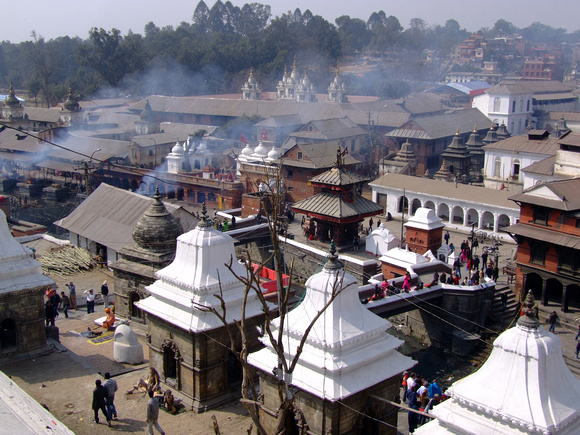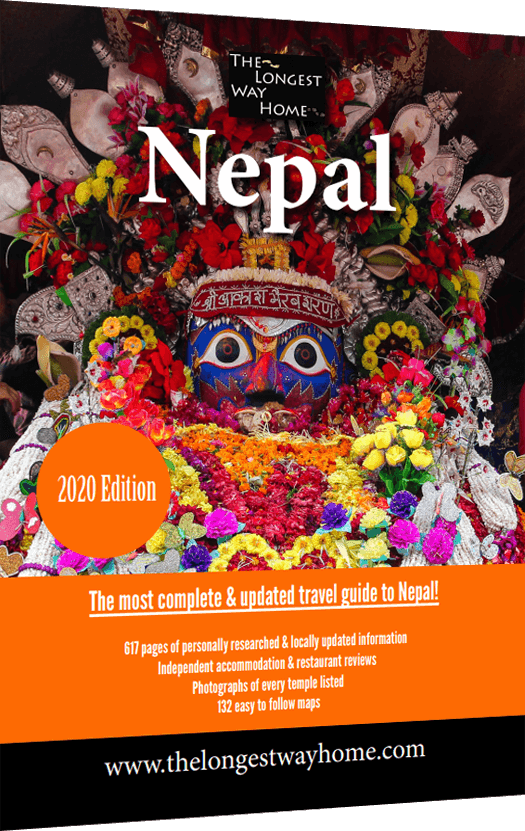

Buying or Using These Photographs: These images are copyright protected. To purchase a print, visit my Nepal travel photography gallery. For personal or commercial use, contact me directly.
Maha Shivaratri in Nepal: A look into the Festival of Lord Shiva
Maha Shivaratri is a whirlwind of devotion, chaos, and raw energy that sweeps through Nepal each year. Celebrated in late winter—typically February or March—this Hindu festival honors Lord Shiva, the enigmatic deity of destruction, renewal, and yogic mastery. Of all the festivals I’ve experienced across Nepal over the years, this one stands out as my favorite. It’s unpolished and authentic, drawing fewer tourists thanks to its timing at winter’s end, leaving you surrounded by Nepali and Indian pilgrims in a cultural immersion that feels genuine and unscripted.
But don’t let the sparse tourist presence fool you—Maha Shivaratri is intense. The crowds are suffocating, the air thick with cremation smoke and rhythmic chants, and there’s a lingering sense that its current form, especially at Kathmandu’s Pashupatinath Temple, might not last. Rising entry fees and shifting policies cast a shadow over its future. In this detailed guide, I’ll unravel the festival’s rich history, its vibrant modern celebrations, my personal tales of navigating the mayhem, and the upcoming Maha Shivaratri dates for 2025-2029 to help you plan your own journey.
The History and Meaning of Maha Shivaratri

Lord Shiva is a deity of paradoxes in Hindu mythology. He’s the ascetic god of yogis—self-controlled, meditative, and celibate—yet a passionate lover to his wife, Parvati (Shakti). Known as the destroyer of the world in the Hindu trinity alongside Brahma and Vishnu, Shiva’s blue throat tells a story of sacrifice: he drank a cosmic poison, the Halahala, to save the universe during the churning of the ocean. Parvati, in a desperate act, tightened a noose around his neck to trap the venom, staining his throat blue forever. This iconic image of Shiva—serene yet fierce—defines his worship.
“Maha Shivaratri,” or “the Great Night of Shiva,” is a festival dedicated to this complex deity, marked by fasting, prayer, and all-night vigils beneath a moonless sky.
Its origins are woven into myth, with multiple tales vying for prominence. Two are most widely embraced:
- Parvati’s Devotion: On the 13th night of the new moon in Phalguna, Parvati undertook intense prayers and meditation to shield Shiva from lurking evil. Her love and resolve are said to have birthed this night of reverence, a tradition carried forward by millions.
- Shiva’s Salvation: As the world faced annihilation during the Samudra Manthan (ocean churning), Parvati begged Shiva to intervene. He declared this night sacred, vowing to bless all who worshipped him, thus naming it “the Night of Shiva.” It’s a tale of cosmic stakes and divine grace.
Other stories enrich the lore—some link Shivaratri to Shiva’s Tandava, the cosmic dance of creation and destruction, performed under the stars. Others tie it to his marriage to Parvati, a union celebrated with feasting and song. Whatever the root, the festival fuses solemnity with celebration, mirroring Shiva’s dual essence.
How Maha Shivaratri Unfolds in Nepal Today
Nepal’s festival scene is usually a spontaneous eruption—you wake up to horns, drums, or a sudden parade with no heads-up. Maha Shivaratri breaks that mold. Word spreads a full week ahead—whispers in tea stalls, chatter on rickety buses—a rare buildup that underscores its towering significance. For many Nepalese Hindus, it’s *the* festival of the year, outranking even Dashain or Tihar in spiritual heft.
The prelude kicks off with the Sadhus, the ash-smeared holy men who channel Shiva’s ascetic spirit. About a week out, they trickle into Kathmandu—some barefoot, others with matted hair trailing down their backs, staffs in hand. Most have trekked from India or Nepal’s remote hills, their pilgrimage converging on Pashupatinath Temple, the beating heart of Shivaratri in Nepal.

Pashupatinath: The Sacred Epicenter
Pashupatinath isn’t just a temple—it’s a sprawling sacred complex, the oldest Hindu temple in Nepal, and a UNESCO World Heritage site. Nestled along the Bagmati River, its ghats hum with cremations, smoke curling into the sky as priests chant. Non-Hindus can’t enter the main sanctum, but the surrounding grounds are a maze of smaller temples, stupas, statues, and resident Sadhus. I’ve wandered it dozens of times outside festival season, struck by its weathered charm, but Shivaratri turns it into a sensory onslaught—electric, chaotic, and utterly unforgettable.
The Bagmati itself is a paradox: revered as holy yet choked with pollution from cremation ashes and decades of refuse dumping. It’s a stark symbol of Nepal’s struggle to preserve tradition amid modern pressures. Still, its role in bathing the dead and scattering their ashes keeps it central to Shivaratri’s rituals.
The Cost of Devotion
Pashupatinath’s sanctity now carries a hefty price tag. Tourists pay 1,000 NPR (about $7.50 USD in March 2025) year-round to enter the complex—not the temple, just the grounds. Locals typically get in free, but on Shivaratri, everyone’s hit with the same 1,000 NPR fee. The administration claims it’s for maintenance and crowd control, citing an annual income topping 50 million NPR (source).

I’ll say it plainly: it doesn’t look renovated—just more crowded and dirtier. On Shivaratri, the fee hike doesn’t thin the masses; it leaves locals—many earning less than 1,000 NPR monthly—queued at locked gates, priced out of their holiest day. It’s a bitter twist to a sacred tradition. My Nepal guidebook offers a workaround, mapping the full complex beyond the tourist traps.
My Shivaratri Adventures at Pashupatinath
Visiting Pashupatinath during Shivaratri is an endurance test. I start at dawn, taking public transport—a rattling bus or cramped microvan—to the crowd’s edge, then trudge an hour through a swelling sea of pilgrims. It’s a crush from the start, and I can’t stress this enough: go with Nepalese friends or a guide. They’ll anchor you when the chaos peaks, especially as the day wears on.
Descending the hill toward the temple, you’re swept into a human tide—gentle but unyielding, shoulders pressing against you, the air heavy with sweat and incense. Blockades try to split those entering from those leaving, but in Nepal, organization is more hope than reality. I’ve been separated from friends here, shoved sideways by the flow, my shouts lost in the din. Linking arms or forming a shoulder-to-waist chain helps, though it’s not foolproof—once, I lost my grip and spent 20 minutes weaving back through the throng to find my group.
Paying to Enter—or Sneaking In?
The 1,000 NPR fee on Shivaratri forces a choice. It doesn’t grant temple access—just a spot in the sweaty, jostling crowd along the ghats. Tensions flare here; I’ve had locals—self-appointed enforcers—insist foreigners shouldn’t be in certain areas (technically just the temple, but they overreach). Ignoring them works, or let your Nepalese friend snap back in rapid-fire Nepali.
One year, I managed to unintentionally miss the fee entirely. With a mix of tourist and local friends, I slipped through a narrow passage I’d found in 2008—a crumbling alley off the main path—emerging in a quiet corner where locals sneaked in too. It’s trickier now with tighter security, but a savvy guide might know the backways. If you pay, brace for chaos over clarity.
The Atmosphere at Pashupatinath During Shivaratri
Beyond the crush, the vibe is intoxicating—happy, reverent, and raw. From the opposite bank, you’ll see cremations blazing, their smoke curling skyward, while priests bless devotees below the temple’s golden spire. Ancient stupas stand weathered and proud, cheeky monkeys scamper through the crowd, and Sadhus weave their mystic presence into every corner.

The Sadhus: Living Icons of Shiva
Sadhus are the soul of Shivaratri. Covered in ash to mimic Shiva’s pale form, they paint their bodies in vivid reds, yellows, and oranges—some bare save for a loincloth, others fully naked. They’re approachable, often posing for photos (50-100 NPR is the norm now), but it’s their holiest day. Many fast, others drift in hashish-fueled trances after weeks on foot. Look left of the main temple (from across the river) for a courtyard where hundreds rest, eat dal bhat, and share tales—a rare, intimate glimpse into their lives.
Naked Sadhus and Legal Hashish
The naked Sadhus are a spectacle—wandering the ghats, lost in dance or meditation, drawing curious onlookers. It’s normal here, echoing Shiva’s unadorned asceticism. Nepal legalizes hashish just for Shivaratri—one of the world’s few such exceptions. Sadhus smoke openly, pipes glowing amid the crowd. In Kathmandu, vendors hawk hash-laced ladus and “special” lassis—tasty but potent. Ask before you bite if you’re not up for a surprise high.
Maha Shivaratri Dates in Nepal: 2025-2029
Planning to dive in? Maha Shivaratri falls on the 13th or 14th night of Phalguna in the Hindu lunar calendar, usually February or March. Here are the projected dates for the next five years:
- 2025: February 26 (Wednesday)
- 2026: February 15 (Sunday)
- 2027: March 6 (Saturday)
- 2028: February 23 (Wednesday)
- 2029: February 12 (Monday)
Note: Lunar dates can shift by 1-2 days. Check my Nepal festival list closer to your trip for updates.
Shivaratri Night in Kathmandu
After surviving Pashupatinath, Kathmandu offers a joyous encore. Bonfires crackle in the streets, feasts of dal bhat, momos, and sweets spill from homes, and locals beckon you to join. It’s a long day—exhausting, disorienting—but the Nepalese warmth turns it into a memory you’ll carry forever.

Preparing for Your Shivaratri Visit
First-timers need a game plan. Arrive a day early to settle in—Kathmandu’s Thamel district has budget guesthouses aplenty, though book ahead for Shivaratri. Public transport is your lifeline—taxis get stuck in the festival snarl. Wear sturdy shoes for the long walk, and pack a scarf; the smoke and dust can choke you. Small bills (50 NPR) are gold—Sadhus expect tips, and vendors don’t always have change. If crowds overwhelm you, stake out a spot across the river for a quieter view.
Will Shivaratri Change in Nepal?
Change is already afoot. Entry fees have soared—1,000 NPR year-round for tourists, now matched for locals on Shivaratri. Non-Hindus face growing scrutiny, a shift from the openness it once reveled in. Hashish’s legal day might vanish too if Nepal’s shaky government tightens up. Like the Holi festival, Shivaratri’s rough charm could fade—go soon to catch it raw.
Why Maha Shivaratri Is a Must-Experience Festival
Shivaratri is Nepal unfiltered—crowded, smoky, and alive with faith. Locals welcome outsiders with open arms, sharing tikka blessings and laughter. If Nepal’s on your list, tweak your timing to catch it. Pair it with my Kathmandu heritage walks from Pashupatinath to Boudhanath for a deeper dive.

For more, my Pashupatinath guide unpacks every nook. It’s a once-in-a-lifetime chance to join a culture at its spiritual zenith—don’t miss it.
Tips for Visiting Maha Shivaratri in Nepal
A few hard-earned pointers:
– Arrive Early:Beat the dawn rush to claim a spot.
– Dress Modestly: Cover shoulders and knees—respect matters.
– Bring Cash: Small bills (50 NPR) for Sadhu photos or snacks.
– Stay Hydrated: Crowds and smoke dehydrate fast—carry water.
– Avoid Peak Hours: Midday is mayhem; early or late is calmer.
Loved This? Grab My Nepal Guidebook!
My guidebook unlocks Nepal—detailed maps, walking tours, temple breakdowns, and handpicked restaurants and lodging. Available for tablets, mobiles, desktops, and print.
Learn more about my Nepal Guidebook






Sounds like a really interesting slice of the Nepalese culture and that headlining photo is a stunner. With the changes possible to come, do you see yourself going back to this festival in years to come?
Hey Ryan,
It’s my second time to be in Nepal at Shivaratri. To be honest for this festival it’s enough. Unless I go back for photos, friends etc. The crowds/costs are simply too much to make it that enjoyable for repeat visits.
The Holi festival on the other hand I would go back to due it’s ever changing nature.
That photo at the top of the sadhu is fantastic. Stunning.
So you paid for the privilege of taking it? I struggle with how I feel about that and in general I won’t pay for photos. But I have a feeling that the sadhus are a different story. I do wonder why they accept money if they are supposed to give up all their worldly goods. Hope you address this stuff in your next post.
Thanks Kristina. Yes I paid the Sadhu. Or as they like to call it, gave him a donation. A long time ago I hesitated with the idea, but in these times I don’t. Not sure if you’ve read this about Photography ethics. An interesting side line to this is that Lonely Planet a few years ago put a Sadhu on the cover of one of their Guidebooks to Nepal. Now whenever your take a photo many Sadhu’s thing it’s for selling or putting on the cover of a magazine or book. A Nepalese translator went so far as to tell me the whole story behind that and other Sadhu photo stories.
I’ve written a little about why the Sadhus take money in the Sadhu post coming up. I might touch again on it in another separate in-depth photo post. As you know I don’t shy away from thing like that. The Sadhus are changing just like everything else!
The first photo is a classic. Well narrated.
Quite informative Whets my curiosity.
Your suggestions are very interesting, together with some hisstory, and mostly your descrption of the atmosphere, that I like the most!
Great article. I’m not a fan of crowds and those scenes look intense. Is it dangerous at all? And what about pickpockets?
I’d only say it’s as dangerous as any other place where there are huge crowds gathering. I’ve never heard of pickpockets there, but have heard lot’s of warnings. That said I would advise taking extra precautions like many locals and not carry anything too valuable.
Fantastic photo of the Saddhu, Dave!
Saddhus scare me. Maybe it’s because the hash, ash and dreds make them look so wayward and transient or quite probably, its the fact they always walk with their smiling palm open to me if they so much see a glimpse of my dangling camera. As “holy men” they’re supposedly not to handle money and things of the material world (which they’ve disowned). To me, that’s sketchy, so I avoid them, even though they’d make an interesting photo.
Not sure if you mentioned it, but the ash they wear is symbolic of Shiva also… death and destruction. I imagine it helps them with that state of transcendence.
Great informative post as usual! I can understand Nepal raising rates on tourists (though not happy about it). But I find it so disturbing how they’ve not given a break to locals, when it’s their religion and celebration! That’s awful.
Thank you, more to come.
I’m not so overly fond of Sadhus myself. Mainly for the points you mention. I met a lot of local Nepalese who feel the same way too. Sadhus are turning more into walking carnival men than revered holy men. That’s not to say many still don’t respect, fear, and seek them for various reasons. But yes, the money thing is there. Some say it’s a sign of the times. Others say it’s a for profit gimmick. I say there’s a blending going on for many.
The rates for Pashupatinath are higher for tourists and lower for locals during the year. But during Shivaratri it’s raised to 1000-1500 plus for all. Personally, I’m seeing a lot of profit making going within certain circles. But yes, over the years Nepal seems to be putting “tourist” prices on just about everything. It’s getting to the point where you can’t even walk outside without having to pay for it as a tourist.
Awesome photo of the Sadhu mate. Looking forward to the post on them. I’ve got a really off the wall question though. What does the place smell like? With all those cremations and smoke in the air is it bad?
Cheers Stuart. Pashupatinath doesn’t smell as intense as Varanasi in India. Mainly due to the fact it’s a smaller area. If the wind blows in your direction and there’s a cremation going on it simply smells of the wood. The closer you get and yes you will smell something else. If there’s not wind blowing in your direction, then there’s very little smell. Other than from the river which really needs cleaning.
Happy Shivratri and Hat’s off to you! You have covered all the aspects connected to this holy festival. You have traced its historical connections well. India is definitely a land of saints and sages.
Really informative and thorough post, thanks! I really hope I get to go to India one day – all the colours, pictures and people look amazing. If I do I think I need to try and target my visit around one of these festivals – sure there’s enough of them in India :)